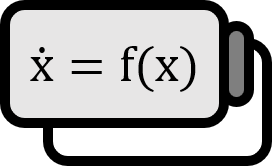Pitchfork Bifurcation
Definition 1 2
Pitchfork Bifurcation refers to a type of bifurcation in dynamical systems where the stability of a fixed point is reversed, and two new fixed points emerge or disappear as a parameter changes.
Normal Form
Pitchfork bifurcation comes in two types: Supercritical and Subcritical, with the following normal forms:
- Supercritical: $$\dot{x} = rx - x^{3}$$
- Subcritical: $$\dot{x} = rx + x^{3}$$
Diagrams
The bifurcation diagrams for pitchfork bifurcation are as follows:
- Supercritical:

- Subcritical:

Explanation

A pitchfork is a farming tool that is sometimes referred to as a hayfork. As can be inferred from its appearance, it is named after the way one fixed point splits into three, resembling a pitchfork, and it’s often mentioned as a textbook example of bifurcation.
Formal Definition 3
For a vector field that is not in normal form $$ \dot{x} = f \left( x, \mu \right) \qquad x, \mu \in \mathbb{R}^{1} $$ to undergo a pitchfork bifurcation at $\left( x, \mu \right) = (0,0)$ means that $x = 0$ is a nonhyperbolic fixed point satisfying the following four conditions: $$ \begin{align*} {{ \partial f } \over { \partial \mu }} (0,0) =& 0 \\ {{ \partial^{2} f } \over { \partial x^{2} }} (0,0) =& 0 \\ {{ \partial^{2} f } \over { \partial x \partial \mu }} (0,0) \ne& 0 \\ {{ \partial^{3} f } \over { \partial x^{3} }} (0,0) \ne& 0 \end{align*} $$ Especially, in the last condition, if ${{ \partial^{3} f } \over { \partial x^{3} }} (0,0) < 0$, it’s supercritical; if ${{ \partial^{3} f } \over { \partial x^{3} }} (0,0) > 0$, it’s subcritical. Meanwhile, $x=0$ being a nonhyperbolic fixed point has the following sufficient condition. It’s not necessary to be exactly $f_{x} (0,0) = 0$, but it’s much simpler. $$ \begin{align*} f(0,0) =& 0 \\ {{ \partial f } \over { \partial x }} (0,0) =& 0 \end{align*} $$
Strogatz. (2015). Nonlinear Dynamics And Chaos: With Applications To Physics, Biology, Chemistry, And Engineering(2nd Edition): p56. ↩︎
Kuznetsov. (1998). Elements of Applied Bifurcation Theory: p62. ↩︎
Wiggins. (2003). Introduction to Applied Nonlinear Dynamical Systems and Chaos Second Edition(2nd Edition): p372. ↩︎
